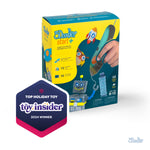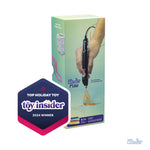STEM: Doodle-Wheelers (Force and Motion/Simple Machines)
In this activity, students will work in pairs to explore the size of wheels and their effects on force and motion. Students will work with a partner to design one small-wheeled and one large-wheeled racer using a clothespin and a 3Doodler. This design project incorporates physics principles in a fun and approachable way.

KnowledgeStudents havehad experience using the 3Doodler to outline and fill shapes.
had experience using the 3Doodler to weld objects together.
had some experience exploring force and motion as part of a larger unit of study.
had experience exploring simple machines, i.e., inclined planes, wheel, and axel.
had experience using the 3Doodler to outline and fill shapes.
had experience using the 3Doodler to weld objects together.
had some experience exploring force and motion as part of a larger unit of study.
had experience exploring simple machines, i.e., inclined planes, wheel, and axel.
ObjectivesStudents willdoodle 4-large wheels and 4- small wheels for two-different sized Doodle-Wheelers.
doodle a third set of wheels that are either smaller or larger than the wheels used in this activity.
predict which Doodle-Wheeler will make it to the bottom of an incline faster.
back up their predictions based on logic and previous experience.
test their Doodle-Wheeler sending them down an incline.
assess what happened, apply and synthesize information to draw conclusions.
retest racers making adjustments to their designs.
doodle 4-large wheels and 4- small wheels for two-different sized Doodle-Wheelers.
doodle a third set of wheels that are either smaller or larger than the wheels used in this activity.
predict which Doodle-Wheeler will make it to the bottom of an incline faster.
back up their predictions based on logic and previous experience.
test their Doodle-Wheeler sending them down an incline.
assess what happened, apply and synthesize information to draw conclusions.
retest racers making adjustments to their designs.
MaterialsStudents will need3Doodler (1 per pair)
Clothespin (2 per pair)
Lego or Lego-sized drivers or doodled drivers (2 per pair)
Glue Stick (1 per pair)
Craft materials to decorate, e.g., google-eyes, feathers, gems, etc.
Cardstock for the track (2 sheets)
Tape (1 roll)
A stack of books for the incline (1 stack per pair)
3Doodler (1 per pair)
Clothespin (2 per pair)
Lego or Lego-sized drivers or doodled drivers (2 per pair)
Glue Stick (1 per pair)
Craft materials to decorate, e.g., google-eyes, feathers, gems, etc.
Cardstock for the track (2 sheets)
Tape (1 roll)
A stack of books for the incline (1 stack per pair)
Lesson PlanInstructions
Step 1Call students to the whole group for discussion.
Share the goal: During this session, students will determine which Doodle-Wheeler is faster: the one with larger wheels, or one with smaller wheels. Show students images of two different size racers.
Step 2Show students where the Doodle-Wheelers will be racing. Stack books and tape a folded cardstock strip as the track. Ask students to predict which Doodle-Wheeler will make it to the bottom of the ramp first and why.
Step 3Project your tablet or computer screen on the board for all students to view the Doodle-Wheelers Instructions/Questions.
Step 4Review the Instructions for making Doodle-Wheelers. Review the two questions.
Step 5Model how to use the wheel stencils to doodle 4 small and 4 large wheels. Note that students must leave a hole to fit the axle. Instruct them to segment off areas on the wheels for easier doodling.
*See Appendix
Step 6Go through the steps of cutting the straw segments and gluing them into the appropriate locations on the clothespin. Note that the straws must be glued further apart for the large-wheeled racers. Place the pre-cut dowels through the two straws. Weld the wheels onto the dowels.
Step 7Weld the Lego-driver into position.
Step 8 - OPTIONALStudents may decorate their clothespins using craft materials, e.g, feathers, gems, google-eyes, etc...
Step 9After reviewing instructions and answering students' questions, hand out Doodle-Wheelers Instructions/Questions. Instruct partners to respond to the first-prediction question before racing their Doodle-Wheelers.
Step 10After racing their Doodle-Wheelers, prompt partners to respond the last question about what actually happened and why.
Step 11 - OPTIONALTake the wheels off of one of their Doodle-Wheelers and doodle an original set of wheels or mix wheels, e.g., two smaller wheels in front, 2 larger wheels in the back. How does this affect Doodle-Wheelers's speed? Instruct students to explore doodling their own wheels or mixing wheels. What happens? Use round objects, like different size lids, to draw stencils for wheels.
Call students to the whole group for discussion.
Share the goal: During this session, students will determine which Doodle-Wheeler is faster: the one with larger wheels, or one with smaller wheels. Show students images of two different size racers.
Show students where the Doodle-Wheelers will be racing. Stack books and tape a folded cardstock strip as the track. Ask students to predict which Doodle-Wheeler will make it to the bottom of the ramp first and why.
Project your tablet or computer screen on the board for all students to view the Doodle-Wheelers Instructions/Questions.
Review the Instructions for making Doodle-Wheelers. Review the two questions.
Model how to use the wheel stencils to doodle 4 small and 4 large wheels. Note that students must leave a hole to fit the axle. Instruct them to segment off areas on the wheels for easier doodling.
*See Appendix
Go through the steps of cutting the straw segments and gluing them into the appropriate locations on the clothespin. Note that the straws must be glued further apart for the large-wheeled racers. Place the pre-cut dowels through the two straws. Weld the wheels onto the dowels.
Weld the Lego-driver into position.
Students may decorate their clothespins using craft materials, e.g, feathers, gems, google-eyes, etc...
After reviewing instructions and answering students' questions, hand out Doodle-Wheelers Instructions/Questions. Instruct partners to respond to the first-prediction question before racing their Doodle-Wheelers.
After racing their Doodle-Wheelers, prompt partners to respond the last question about what actually happened and why.
Take the wheels off of one of their Doodle-Wheelers and doodle an original set of wheels or mix wheels, e.g., two smaller wheels in front, 2 larger wheels in the back. How does this affect Doodle-Wheelers's speed? Instruct students to explore doodling their own wheels or mixing wheels. What happens? Use round objects, like different size lids, to draw stencils for wheels.
Wrap Up
Assessment
Possible Extensions
Resources
Doodling the Wheels
Assembling the base of the Doodle-Wheeler
Reference Images
Video References
Vocabulary
axle - a rod or spindle (either fixed or rotating) passing through the center of a wheel or group of wheels.
cars - a road vehicle, typically with four wheels, powered by an internal combustion engine and able to carry a small number of people.
collaboration - to work jointly with others or together especially in an intellectual endeavor.
construction - the building of something, typically a large structure.
data - factual information (such as measurements or statistics) used as a basis for reasoning, discussion, or calculation.
design - to prepare the preliminary sketch or the plans (for a work to be executed), especially to plan the form and structure of an object, building, bridge, etc...
engineering - the art or science of making practical application of the knowledge of pure sciences, as physics or chemistry, as in the construction of engines, bridges, buildings, mines, ships, and chemical plants.
force - strength or energy as an attribute of physical action or movement.
inclined plane - slope or ramp that makes it easier to lift something
motion - the action or process of moving or being moved.
problem-solving - the process or act of finding a solution to a problem.
racers - an animal or means of transportation bred or designed especially for racing
simple machines - any of the basic mechanical devices for applying a force, such as an inclined plane, wedge, or lever.
STEM - science, technology, engineering, and mathematics, considered as a group of academic or career fields.
transportation - the action of transporting someone or something or the process of being transported.
wheel - a circular object that revolves on an axle and is fixed below a vehicle or other object to enable it to move easily over the ground.
Educational Standards
Participate in collaborative conversations with diverse partners about grade level topics and texts with peers and adults in small and larger groups.
Students will discuss how to design the fastest Doodle-Wheeler using small and large wheels, comparing the results, making design improvements and retesting.
Build on others' talk in conversations by linking their comments to the remarks of others.
Students will build on the talk in conversations with others during the group discussion and the work with their partner throughout this project.
Analyze to determine if a design solution works to change the speed or direction of an object with a push or a pull.
Students will design a third Doodle-Wheeler using wheels they design with a partner or mixing smaller and larger wheels on one racer to determine if they can improve their Doodle-Wheeler's speed.
Decompose (break down) a larger problem into smaller sub-problems with teacher guidance or independently.
Students will break down the process of designing and constructing the fastest Doodle-Wheeler through drafting, modeling, testing, improving and retesting.
Use technology to seek feedback that informs and improves their practice and to demonstrate their learning in a variety of ways.
Students will use a 3Doodler to design and doodle wheels for their Doodle-Wheelers.
Create original works or responsibly repurpose or remix digital resources into new creations.
Students will design a new Doodle-Wheeler using a mixed set of wheels or by innovating new wheels for their racers.
Use collaborative technologies to work with others, including peers, experts or community members, to examine issues and problems from multiple viewpoints.
Students will work with a partner and peers throughout the doodling process, problem solving process, and assembly process. Students will share their perspectives.





